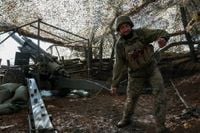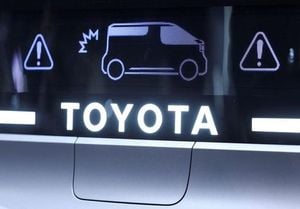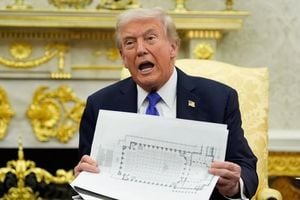As the war in Ukraine grinds into its fourth year, the eastern city of Pokrovsk has emerged as the latest flashpoint in the ongoing struggle between Russian and Ukrainian forces. Over the past week, reports from both sides have painted a picture of escalating violence, shifting frontlines, and a city teetering on the edge of a new phase in the conflict. The fate of Pokrovsk, a once-bustling hub in the Donetsk region, now hangs in the balance as both militaries dig in for what could be a decisive confrontation.
On October 29, 2025, Russian President Vladimir Putin made a bold announcement: units of the Ukrainian Armed Forces had been encircled near Pokrovsk and Kupyansk, two strategic locations in the embattled east. According to Modern.az, Putin further declared Russia’s readiness to call a ceasefire in these areas and even invited media representatives to witness the situation firsthand. Almost immediately, Russian media outlets and military-linked Telegram channels claimed that Pokrovsk and its surrounding neighborhoods had fallen under Russian control, with the Russian flag reportedly raised in some parts of the city.
Yet, the reality on the ground is far more complicated. The "DeepState" monitoring project, which tracks frontline changes, reported that a significant portion of Pokrovsk remained a “gray zone”—territory where neither side could claim undisputed authority. According to DeepState, Russian troops had advanced into the northern reaches of the city, deploying sabotage groups of 200 to 300 soldiers in various buildings. These developments, echoed by BBC analysis, suggest that after the capture of Avdiivka earlier in the year, Russian forces had redirected their main offensive towards Pokrovsk, advancing up to 40 kilometers within six months. The fighting now rages in both the northern and southern sectors of the Pokrovsk-Myrnohrad agglomeration, putting immense pressure on Ukrainian defensive lines.
Pokrovsk’s significance cannot be overstated. As a key road and rail hub in the Donetsk region, it once boasted a pre-war population of around 60,000. Most residents have since fled, with all children evacuated and only a handful of civilians remaining amid the ruins. The city’s location on a vital supply route has made it a lifeline for Ukrainian military operations in the east. Just 10 kilometers to the west lies Ukraine’s only coking coal mine, essential for the country’s steel industry, though operations there were suspended in January 2025, according to Metinvest. The region’s largest and oldest technical university, once a symbol of local pride, now stands abandoned after sustaining heavy shelling.
For Moscow, the capture of Pokrovsk would represent a major strategic victory. Russian media have dubbed the city “the gateway to Donetsk,” and its fall would open the path north toward Kramatorsk and Sloviansk—the last major Ukrainian-controlled cities in Donetsk. The broader objective, as President Putin has repeatedly stated, is to seize the entirety of the Donbas region, comprising both Luhansk and Donetsk provinces. Russia currently controls about 90% of Donbas, with Ukrainian forces holding onto roughly 5,000 square kilometers in the west.
But why has the battle for Pokrovsk dragged on for so long? Unlike previous offensives—most notably the bloody, head-on assault on Bakhmut—Russian commanders have adopted a more methodical approach. Employing a pincer movement, their forces have nearly encircled Pokrovsk, threatening Ukrainian supply lines and sowing confusion among defenders. Small, highly mobile Russian units have infiltrated the city, using drones and hit-and-run tactics to disrupt logistics and create chaos behind Ukrainian lines. This strategy has carved out a “gray zone” of ambiguous control, making it difficult and costly for either side to assert dominance.
Ukrainian authorities, for their part, have pushed back against Russian claims of victory. On October 30, Commander-in-Chief of the Ukrainian Armed Forces Oleksandr Syrskyi visited the Pokrovsk front to assess the situation firsthand. He flatly denied reports that Ukrainian troops had been encircled in Pokrovsk or Kupyansk. “The situation is complex, but manageable. Russian infantry units are trying to avoid battles by hiding and changing positions within the city. We are intensifying the activities of reconnaissance and strike drones, neutralizing the enemy’s covert groups,” Syrskyi stated, as reported by Modern.az. He also issued stern instructions to his commanders to act responsibly or face dismissal, while emphasizing the need to safeguard supply and evacuation routes and, above all, protect the lives of Ukrainian personnel.
President Volodymyr Zelensky echoed this resolve in a statement on October 26, acknowledging the fierce fighting and logistical difficulties but insisting that Ukrainian forces must “continue to destroy the occupiers.” Meanwhile, the pro-Ukrainian DeepState war blogger warned that “the situation in Pokrovsk is on the verge of critical and continues to deteriorate to the point that it may be too late to fix.” According to DeepState, Russian infiltration of the city remains ongoing, with Ukrainian defenders reinforcing positions as best they can.
On the Russian side, Chief of the General Staff Valery Gerasimov informed Putin on October 26 that Russian forces had managed to block a large number of Ukrainian soldiers in the area, and that Ukraine’s top units had withdrawn. Russian military bloggers have described the current situation as a near-total encirclement, with only limited Ukrainian access to the city’s supply routes.
Beyond Pokrovsk, the broader front remains volatile. Russian advances have also threatened Kupyansk in the Kharkiv region, as well as areas in Dnipropetrovsk and Zaporizhzhia. As of late October 2025, Russia claims to control more than 19% of Ukraine—about 116,000 square kilometers. Moscow now considers Crimea, Luhansk, Donetsk, Zaporizhzhia, and Kherson as subjects of the Russian Federation, though Kyiv and the vast majority of the international community reject these claims. The United Nations General Assembly, in a 2014 resolution, declared the annexation of Crimea illegal and recognized it as part of Ukraine. Only a handful of countries, including Syria, North Korea, and Nicaragua, have recognized Moscow’s annexation of Crimea.
Amid the fog of war, the true state of control in Pokrovsk remains uncertain. As of October 31, the "DeepState" map still shows the eastern part of Pokrovsk and Myrnohrad as a “gray zone,” reflecting the ambiguous and contested nature of the battle. Reporting from the war zone is severely restricted, making independent verification of battlefield claims nearly impossible.
With both sides digging in and neither willing to concede ground, the struggle for Pokrovsk is shaping up to be a pivotal chapter in the war’s next phase. Whether the city falls or holds, its fate will likely reverberate far beyond the battered streets of Donetsk, shaping the contours of a conflict that shows no sign of ending soon.




